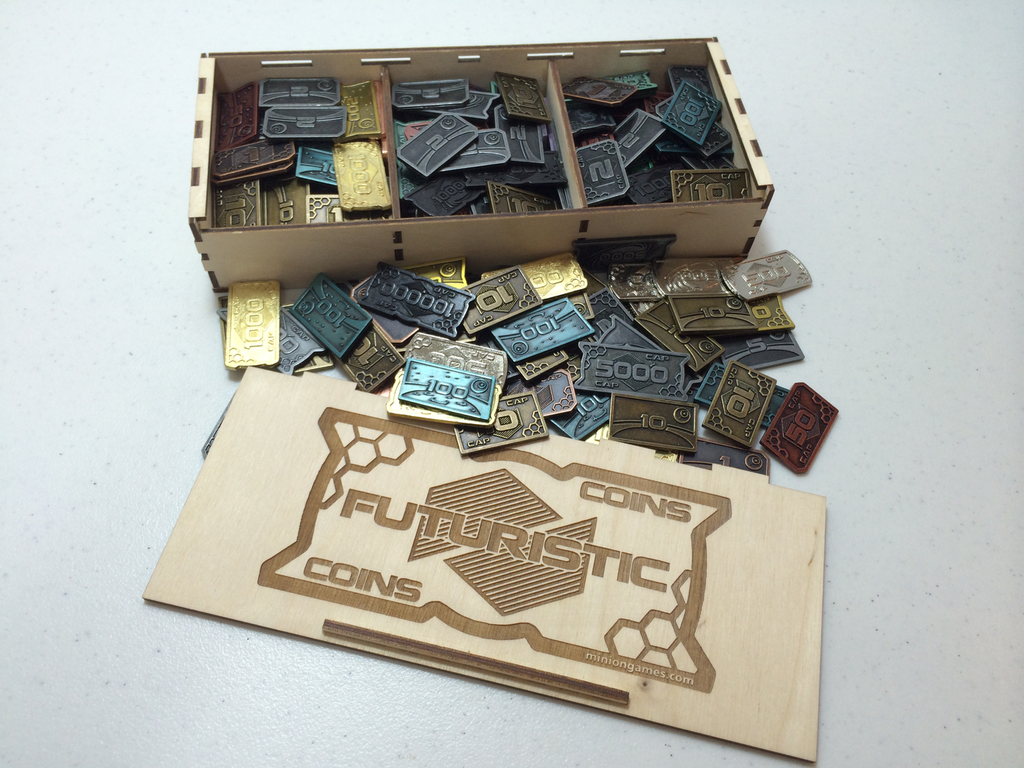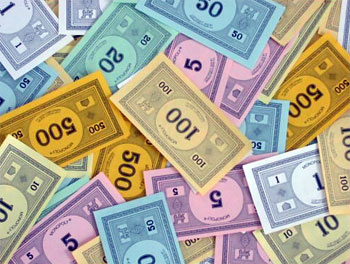There is some major hatred over the inclusion of paper money in board games. Clearly, there's a mental association to Monopoly, a game that many older board gamers experienced in their youth. With a slew of unfinished games, number-crunching rents, and messy box innards before and after every setup, Monopoly memories are not particularly the fondest. With that going for it, is it any surprise for all the distaste?
Let's see what makes people hate paper money.
It's Paper
With board games veering more towards cardboard tokens, the tactile feel for less-sturdy components becomes less appealing. Paper money's flimsey and cheaply made, and it's suppose to represent treasured wealth? It's smaller than your traditional bill, with gaudy colors. I've blown my nose on more sturdier tissues than this.
To call play currency "paper" is insulting to the word itself. It's more akin to tissue paper. When you fan out a stack of paper bills, it limps backwards, almost mocking your fake wealth. Plopping your "fat stack" of $500 feels a bit thin under the palm of your hand. You can't even take all the paper money in the game and put it in a fancy metal suitcase to feel even remotely like a big shot.
Also, the handling of paper money is a bit dodgy. I think we've all done the "damnit I just wanted to pick up a single bill" finger dance more than once in our gaming lives. There's also the "sliding until you find a table edge to pick up a single bill" or "wetting your fingertips with your mouth to carefully count out your payment" moments that we can sooner forget.
To top it all off, it's the first to waver at the slightest moment of bad luck. Spill a drink? It turns into a wobbly mess. Small gust of wind? Blows away in a feathery cloud of whimsy. Just holding them in your burly hands? Crumpled wads. They just can't get a break!
It's Not Relevant
Let's think about this for a moment. Monopoly was released by Parker Brothers in 1935 during a time in which payment through means other than paper currency was very infantile and not widely used. Without going through the entire history of the credit card, the short story is that it wasn't widely commercially used until the late 1950s. So, having a wad of cash was the definition of wealth, and to empower players in a board game with wads of fake paper cash was probably the best feeling anyone could have. Admit it, when you played Monopoly and started acquiring $100 and $500 bills, you flaunted it to others, waving it over their heads in a fan-shape.
During a remodeling phase in 2005, Monopoly got a makeover in their "Here and Now" edition, which included an "electronic banking" edition that replaced their paper money with electronic debit cards. In one fleeting moment, the same company that brought paper money into our board gaming lives decided to roll with the times and move on to digital funds. You can't help but feel a sense of abandonment there.
The Exceptions
I understand all the cons for paper money, how people would rather handle cardboard tokens, or poker chips, or wooden markers, or dirty needles. I get it. But let's stop and consider, for one moment, that paper money may be essential to a game's theme. For Monopoly, it was entirely relevant in its day. The status of a wealthy individual was marked by wads of cash, and for a player to have a fist full of fake dollars in their hands is the ultimate in "MWAHAHA." What current games out there, then, wave their paper money currency flag high and proud?
Ladies & Gentlemen
It's the age-old cliche of the working man tirelessly earning his wage to frivolously spend on his doting wife, back in the days when men earned their keep playing the stock market, while women find out what dresses they want to wear. Yes, it's a period themed game where women shopped a lot, and mooched off from their husbands' hard-earned cash. So, what better way to represent this than having paper money?
The paper money serves in the coy interaction between the "husband" and "wife." When completely immersed, the "husband" may flaunt their daily earnings, casually remarking to their "wife" to go ahead and pick out anything they want to buy. As they merrily grab their purchases, you slowly (and deliberately) count your bills like the fat cat you're portraying. And while the bill value may be printed only on one side, its purpose is entirely intentional, as the earnings for each player is hidden from the other teams.
Lords of Vegas
Set in 1941, players play as wealthy investors looking to build Las Vegas into what we know it to be today. This involves earning cash from owned lots to build casinos, sprawling and expanding them, while gambling a little on the side. And back then, this was all done with the power of paper bills, so paper money is quite prevalent in this game. There's even a little fun in these double-sided currency, putting famous Las Vegas icons as the faces of the bills.
A quick browse in BGG shows that a lot of people are replacing the paper money with poker chips, in lieu of the Vegas theme in the board game. While that's fine and good, I feel it somewhat threatens the theme a little. Investors went around with suitcases of money (each bill represents millions), buying up properties and casinos. If you must use poker chips in the game, consider converting it only when people decide to gamble it in other casinos. No investor is walking around old Vegas with a pocket of chips.
Firefly: The Game
If Monopoly was the "paper money" of paper money, then the currency in Firefly is absolutely legit. These double-sided, full-color, feels-good-in-your-hands money is absolutely gorgeous! Having to spend these for goods and services is almost a crime. You immediately feel a sense of ownership when you hold them in your hand, and there's a slight moment of hesitation when contemplating your purchase.
Sure, some fans may quibble that it's not EXACTLY the same as the money used in the show, but it's a pretty damn good attempt at it, furthering the immersion of the game's theme. You ARE a crew of misfits, flying around in the 'Verse, with a limited amount of cash on hand. Money is supreme here, and it's only fitting that it stands out as a star of its own.
It's Still Paper...
Paper money has received a bad rap, with plenty of prominent boardgame reviewers out there that strongly advocate against it with a passion. And I get it. The "play" aspect invokes a lot of childish association with the fake currency, with its wildly-abstract colors, its flaccid structure a perfect example of it not taking itself seriously. But, when games leverage their qualities, traits, and relevance to the gameplay and theme, they become as much a part of the game as any other component.
 |
| Metal coins by Minion, which you can find here. |
In fact, even cardboard coins are joining paper money in the backseat, with people opting for customized metal coins to REALLY intensify the theme for themselves. All for the sake of adding value to the game.
Boardgame developers know this. They are aware of this. The proof of which are in the examples above. It's not your parents' Monopoly money anymore. They have character, purpose, and a stronger presense before. With the games mentioned above, it's harder to blindly dismiss paper money.
If you still insist on using something else instead of the paper money provided, I won't stop you. But the next time you consider this, think about it. That paper money may have more value than you think.









No comments:
Post a Comment